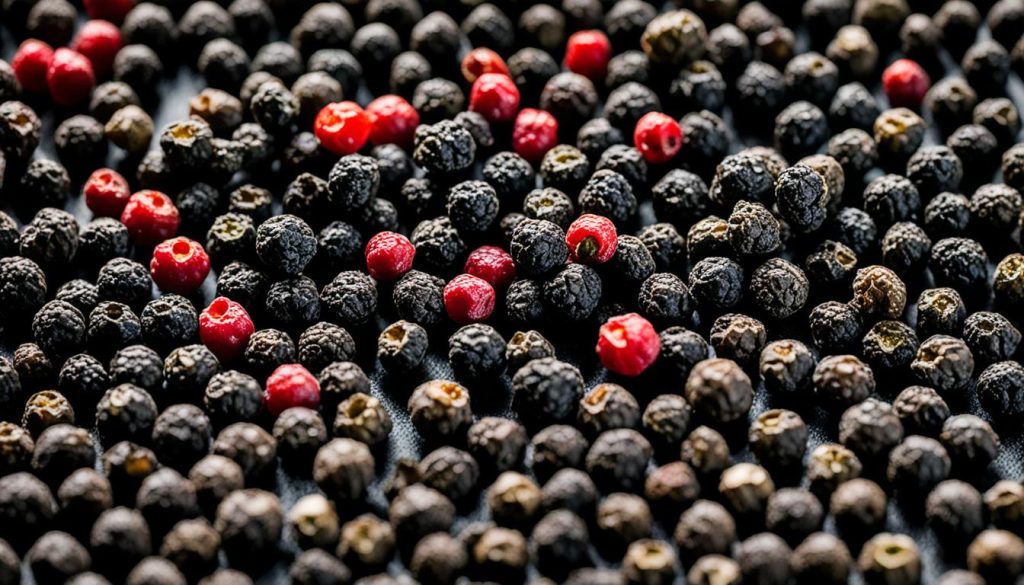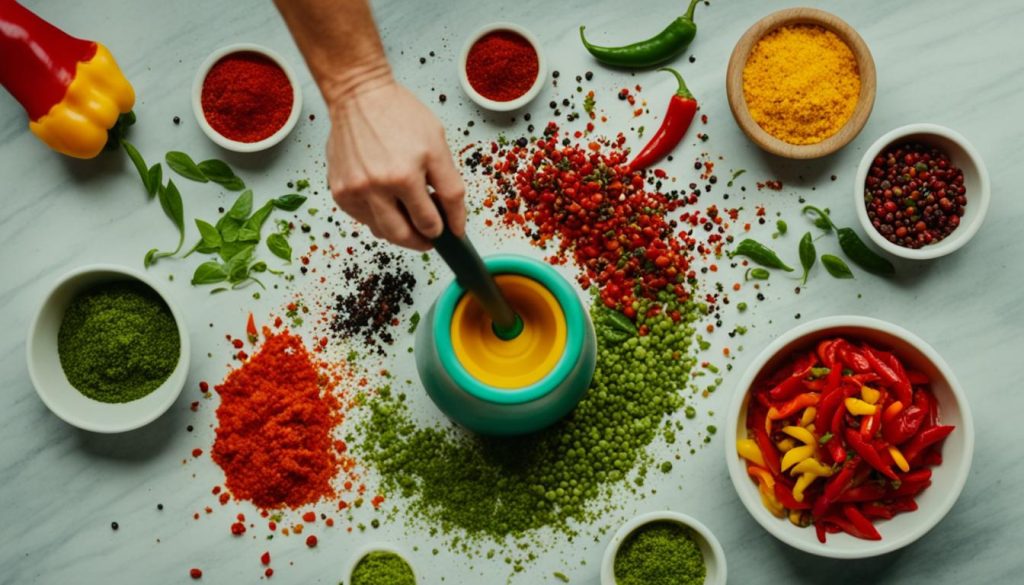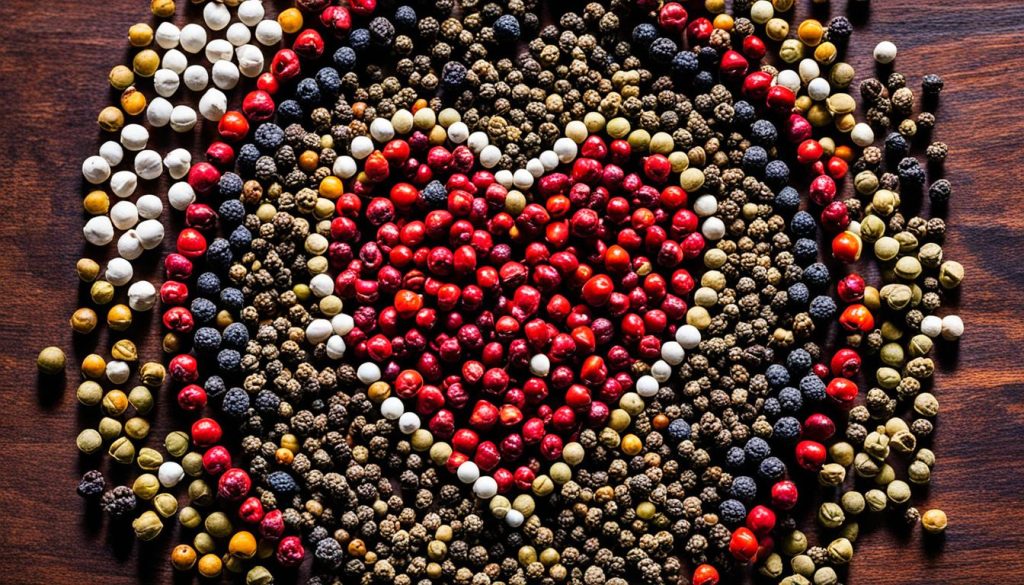I love food and always wanted to know more about pepper. This spice has been important in cooking for a long time. It traveled the world and became a key flavor in many dishes.
This article takes you on a spicy trip. We’ll look at pepper’s history, its many types, and how it makes food taste better. From the simple black peppercorn to the hot Carolina Reaper, there’s a lot to learn.
If you like cooking or just enjoy trying new foods, this journey is for you. It will make you excited to use pepper in your cooking. Let’s start exploring pepper’s role in food and the exciting flavors it adds.
Pepper: From Ancient Trade Routes to Modern Kitchens
The history of pepper goes way back to ancient times. It was a key spice in the spice trade. It started in India and Southeast Asia. Then, traders and explorers took it to other parts of the world.
Tracing the Spicy History of Pepper
Pepper has been loved for ages. It was once a luxury item but now it’s a common spice in many dishes. As the world got smaller, pepper became easier to get and use in cooking.
Pepper’s Journey: From Exotic Lands to Global Prominence
Pepper’s story is full of cultural exchange and new flavors. It traveled the world and became a favorite in many cuisines. Now, it’s a key spice in kitchens everywhere, loved by cooks and chefs.
| Timeline | Pepper’s Milestones |
|---|---|
| Ancient Times | Pepper originates in India and Southeast Asia, becoming a highly prized commodity in ancient trade routes. |
| Middle Ages | Pepper becomes a symbol of wealth and power, with European nobility using it to showcase their affluence. |
| 16th-18th Centuries | Pepper’s popularity spreads globally as European explorers and traders introduce it to new regions and cuisines. |
| Modern Era | Pepper becomes a ubiquitous spice, available in households worldwide and used in a wide variety of culinary applications. |

“Pepper was once more valuable than gold. Its journey from the exotic lands of the East to the kitchens of the world is a testament to its enduring appeal and the power of global trade.”
Different Types of Peppercorns and Their Unique Flavors
The world of peppercorns is full of flavors and uses. Black pepper is the most used spice, known for its strong, earthy taste. But there are more spices to try.
Black Pepper: The Classic Spice Staple
Black peppercorns come from the Piper nigrum plant. They are used all over the world. Their strong flavor makes them great for many dishes, like stews and breads.
Black pepper adds a special aroma and heat to food. It’s a must-have in many kitchens.
White Pepper: The Milder, Refined Cousin
White peppercorns are different from black ones. They have a softer taste because their skin is removed. They are used in dishes that need a gentle heat and flavor, like creamy soups.
Green Peppercorns: A Burst of Fresh Flavor
Green peppercorns are picked before they ripen. They have a fresh, herb-like taste. They add a unique flavor to many dishes, from Thai curries to sauces.
| Peppercorn Type | Flavor Profile | Culinary Uses |
|---|---|---|
| Black Pepper | Bold, earthy, pungent | Savory dishes, grilled meats, baked goods |
| White Pepper | Mild, refined | Creamy soups, light sauces, delicate seafood |
| Green Pepper | Fresh, herbaceous | Thai curries, Vietnamese dishes, sauces, marinades |

Exploring peppercorns opens up new cooking possibilities. From the well-known black pepper to the subtle white and bright green, each type adds special flavors. Let peppercorns take your cooking to the next level.
Pepper: Unleashing a World of Culinary Possibilities
Pepper is a key player in cooking, often overlooked but always essential. It brings a unique flavor and aroma to dishes. Whether it’s meats, veggies, sauces, or dressings, pepper makes them better.
Elevating Dishes with Pepper’s Versatility
Pepper is more than just a seasoning. It fits into many cooking methods like grilling, sautéing, roasting, and braising. Adding pepper to a steak, stew, or salad can change the whole taste. It brings out flavors that make dishes pop.
Pairing Pepper with Other Spices and Flavors
Pepper’s magic is in how it works with other spices and flavors. Mixing different peppers with ingredients opens up new taste adventures. From black pepper’s earthy taste to white pepper’s citrusy flavor, the options are endless.
| Pepper Variety | Flavor Profile | Complementary Flavors |
|---|---|---|
| Black Pepper | Earthy, robust, and slightly spicy | Roasted meats, potatoes, stews, and sauces |
| White Pepper | Milder, with a slightly sweet and fruity taste | Creamy dishes, seafood, and Asian-inspired cuisine |
| Green Peppercorns | Fresh, bright, and herbaceous | Marinades, sauces, and delicate proteins |
Exploring pepper’s many uses can open up a world of flavors. Home cooks and chefs can make dishes that amaze everyone.

The Health Benefits of Pepper
Pepper is more than just a tasty spice. It’s full of nutrients and antioxidants. These make it great for your health and taste.
Pepper’s Nutritional Value and Potential Health Benefits
Pepper is packed with vitamins and minerals. It’s a top source of vitamin C, which keeps your immune system strong. It also has vitamin K, which is good for your bones.
Pepper is full of antioxidants. These fight off harmful free radicals. They might lower the risk of chronic diseases.
- Improved Digestion: Pepper helps make digestive juices. This can help you absorb nutrients better and ease stomach troubles.
- Anti-Inflammatory Properties: Pepper has compounds that reduce inflammation in the body.
- Potential Cancer-Fighting Effects: Pepper’s antioxidants might stop some cancer cells from growing.
- Enhanced Cognitive Function: Pepper’s compounds could boost brain health. This might help with memory and thinking skills.
Adding pepper to your meals can make them taste better and be healthier. It’s a great way to improve your health and enjoy your food more.

Pepper is not only a flavor powerhouse, but it also boasts an array of potential health benefits.”
Meet the Carolina Reaper: The Hottest Pepper on Earth
A new champion has come to the spicy pepper world – the Carolina Reaper. Ed Currie and his PuckerButt Pepper Company made it. It’s now the hottest pepper on Earth, according to the Guinness World Record.
This pepper has an average Scoville Heat Unit (SHU) rating of 1.64 million. That’s incredibly hot, making even the bravest chili fans sweat and grab milk. It’s a true challenge for anyone who loves spice.
| Pepper Variety | Scoville Heat Units (SHU) |
|---|---|
| Carolina Reaper | 1,641,183 SHU |
| Ghost Pepper (Bhut Jolokia) | 1,041,427 SHU |
| Habanero Pepper | 100,000 – 350,000 SHU |
| Jalapeño Pepper | 2,500 – 8,000 SHU |
The search for hotter peppers keeps going, and the Carolina Reaper leads the way. It’s not for the timid, but for those who love spice. It offers a thrilling spice challenge for those brave enough.
“The Carolina Reaper is the hottest pepper I’ve ever tasted. It’s a true test of one’s spice tolerance and bravery in the kitchen.”
Introducing Pepper X: The Record-Breaking Spice Sensation
A new spice has entered the culinary world, aiming to be the hottest. Pepper X, made by PuckerButt Pepper Company, is now the hottest pepper. It has an SHU rating of 2,693,000, setting a new record.
Unleashing the Fiery Heat of Pepper X
Creating Pepper X was a big challenge. Ed Currie worked hard for years to make a pepper that would break records. His hard work paid off, making a pepper that excites spice lovers and pushes culinary limits.
Pepper X is known for its intense heat and fruity taste. It’s a pepper that will leave a mark on those who try it.
Pepper X: The Future of Extreme Spice?
Pepper X is now the hottest pepper in the world. It’s making people think about extreme spice in new ways. Spice lovers and chefs are excited to see what they can do with this pepper.
This pepper makes us wonder about the future of spices. Will it lead to new and exciting foods? Only time will show, but Pepper X is definitely a big deal in the spice world.
“Pepper X is a game-changer in the world of culinary innovation. Its exceptional heat and unique flavor profile will undoubtedly inspire chefs and enthusiasts to explore new frontiers in the art of spice.”
Spice Up Your Life with Taste Acer’s Pepper Collection
Make your cooking better with Taste Acer’s Spice Collection. It’s full of flavors that will make your dishes exciting. Taste Acer’s Crushed Red Pepper and Cayenne Red Pepper add a spicy kick to many foods, like pizzas and stir-fries. This collection helps both home cooks and chefs find new tastes.
Exploring Taste Acer’s Crushed Red Pepper
Taste Acer’s Crushed Red Pepper adds heat and flavor to your meals. It’s made from top-quality red peppers. Add it to your eggs, stir-fries, or chili for a spicy twist.
Discovering Taste Acer’s Cayenne Red Pepper
If you like strong pepper flavors, try Taste Acer’s Cayenne Red Pepper. It’s made from the famous Cayenne pepper. Use it to spice up grilled meats, dips, or new spicy dishes.
| Product | Heat Level | Uses |
|---|---|---|
| Taste Acer Crushed Red Pepper | Medium-Hot | Eggs, stir-fries, chili, pizza |
| Taste Acer Cayenne Red Pepper | Hot | Grilled meats, dips, spicy recipes |
Discover new flavors with Taste Acer’s pepper collection. Improve your cooking and start a spice adventure.
Flavor Unleashed: Embracing the Spicy Adventure
I love pepper and know it can change your cooking. It’s great for both expert chefs and home cooks. Pepper adds unique flavors and excitement to your food.
Tips for Incorporating Pepper into Your Cooking
Pepper is very versatile. To use it well, learn about different peppercorns. Try black, white, and green peppercorns to make your own spice mixes.
Adding freshly cracked black pepper can make your dishes taste better. White pepper is great for creamy sauces and soups. It adds a subtle touch.
Creating Memorable Pepper-Infused Dishes
- Rub meats and veggies with pepper, garlic, and herbs for a tasty crust.
- Add green peppercorns to marinades for a fresh, herbal taste.
- Put cayenne or red pepper flakes in baked goods for a sweet and spicy kick.
- Use pepper-infused oils and vinegars in dressings and dips for extra flavor.
Have fun with pepper and let your cooking creativity flow. Pepper can open up a world of flavors that will make your guests want more.
The Pepper Phenomenon: A Global Obsession
The world loves pepper more than ever. This spice has won over food lovers everywhere, crossing cultural lines. It’s making cooking more exciting and new.
More people want unique and strong flavors. This has made pepper more popular. Chefs and home cooks are using pepper to make their dishes stand out.
Everyone from pepper experts to spice lovers is trying new things. The variety of peppers available is huge. From the mild black peppercorn to the hot Carolina Reaper, people can’t get enough.
The spice industry keeps coming up with new pepper types. This keeps the pepper craze alive. Pepper is a key part of cooking around the world. It’s loved by food fans everywhere.

